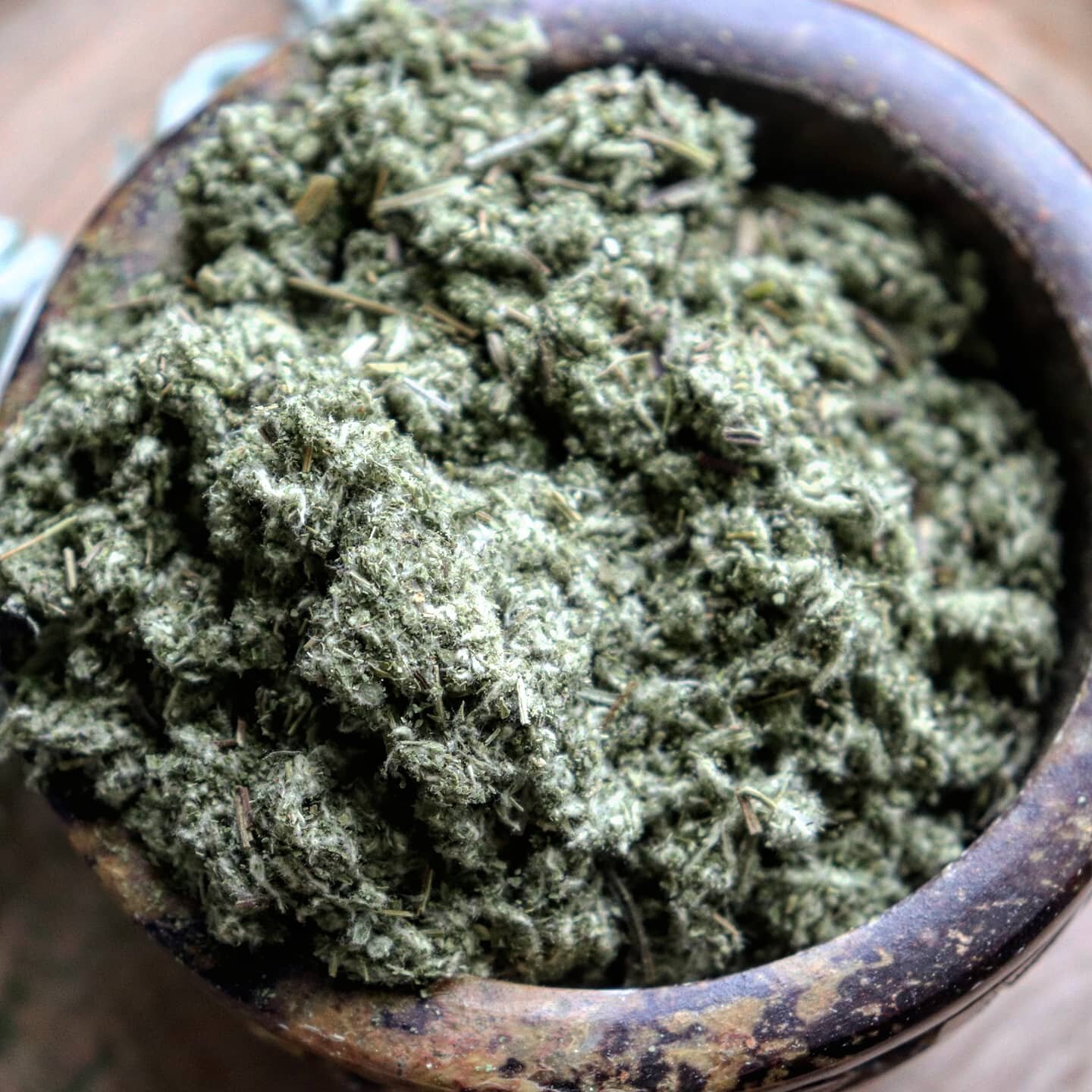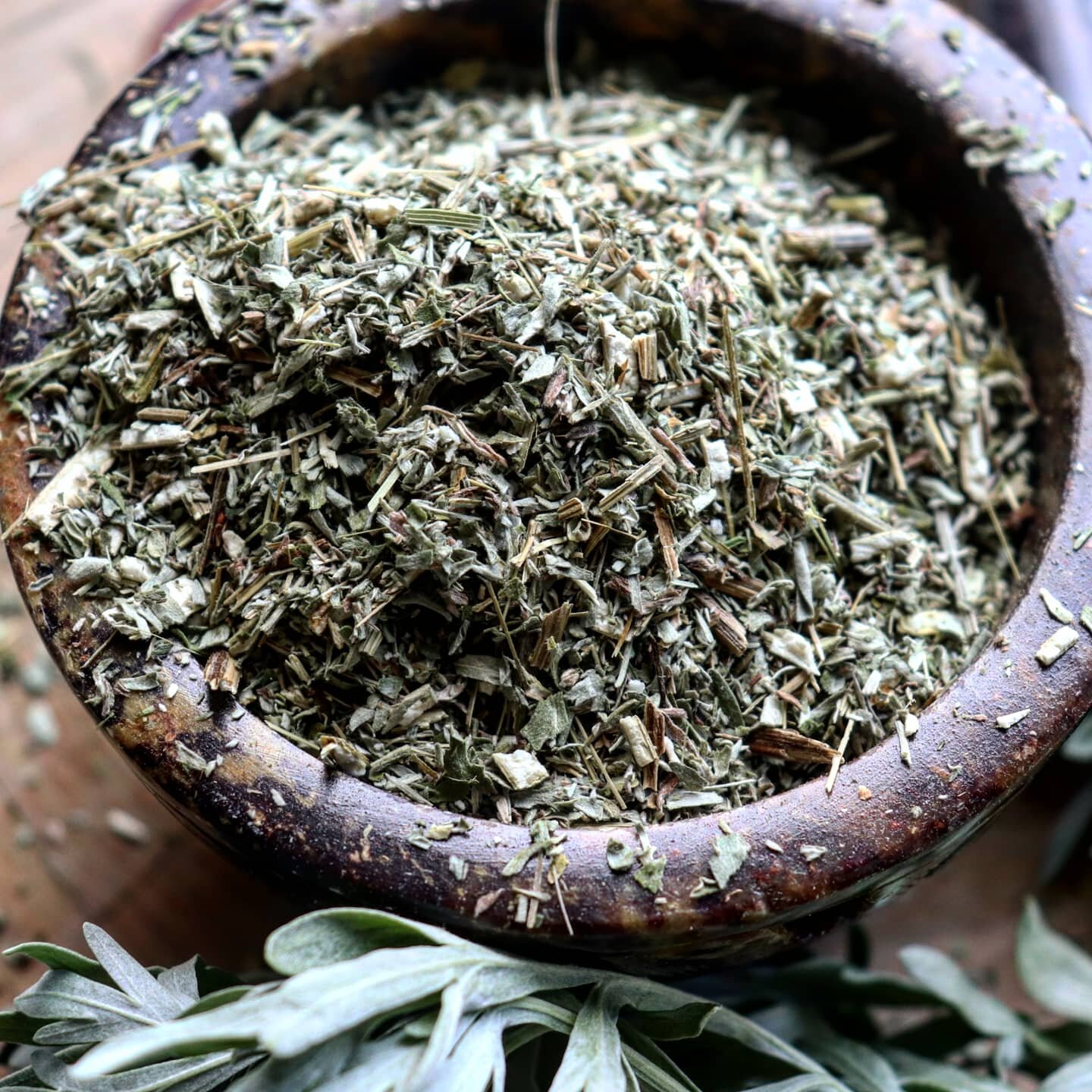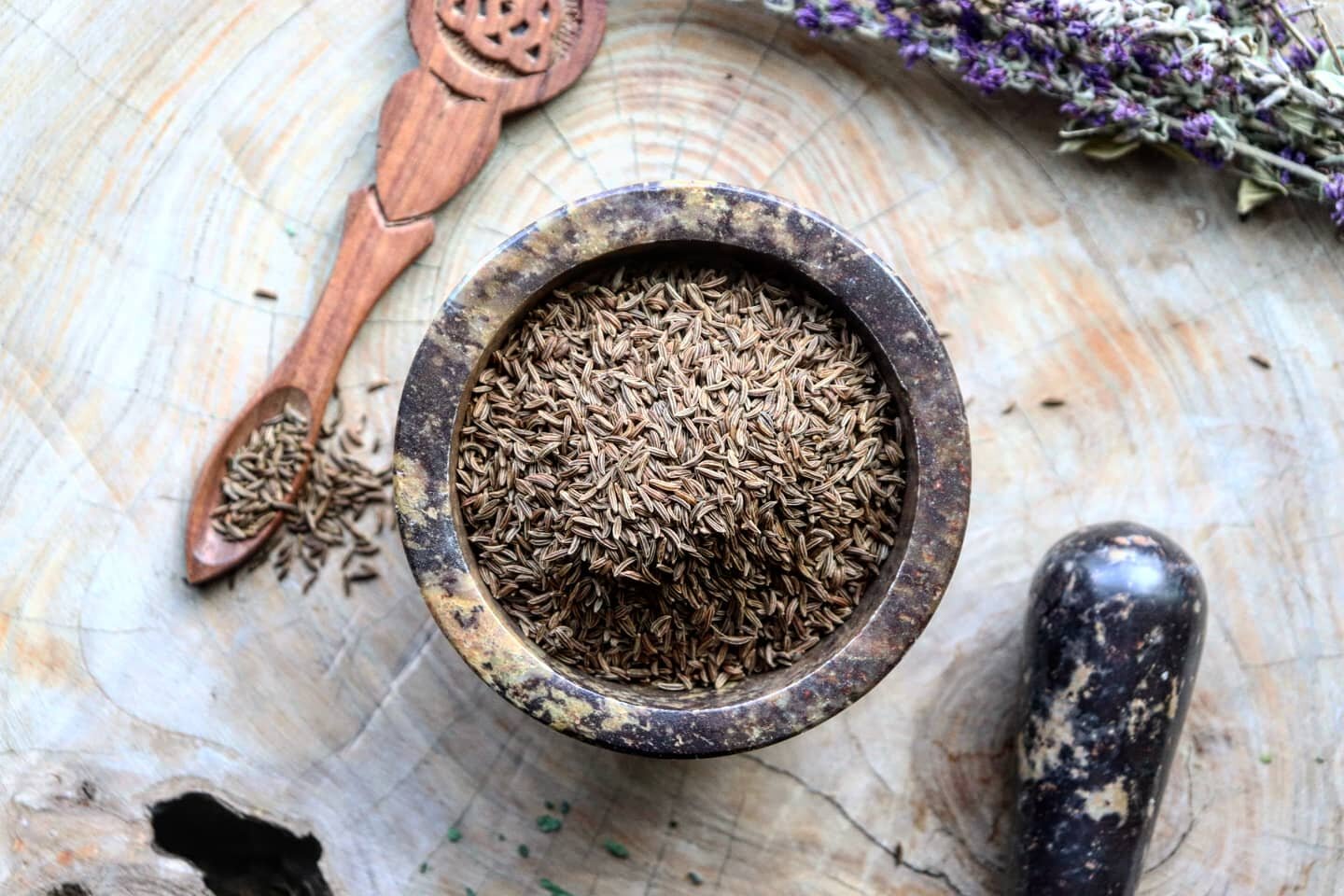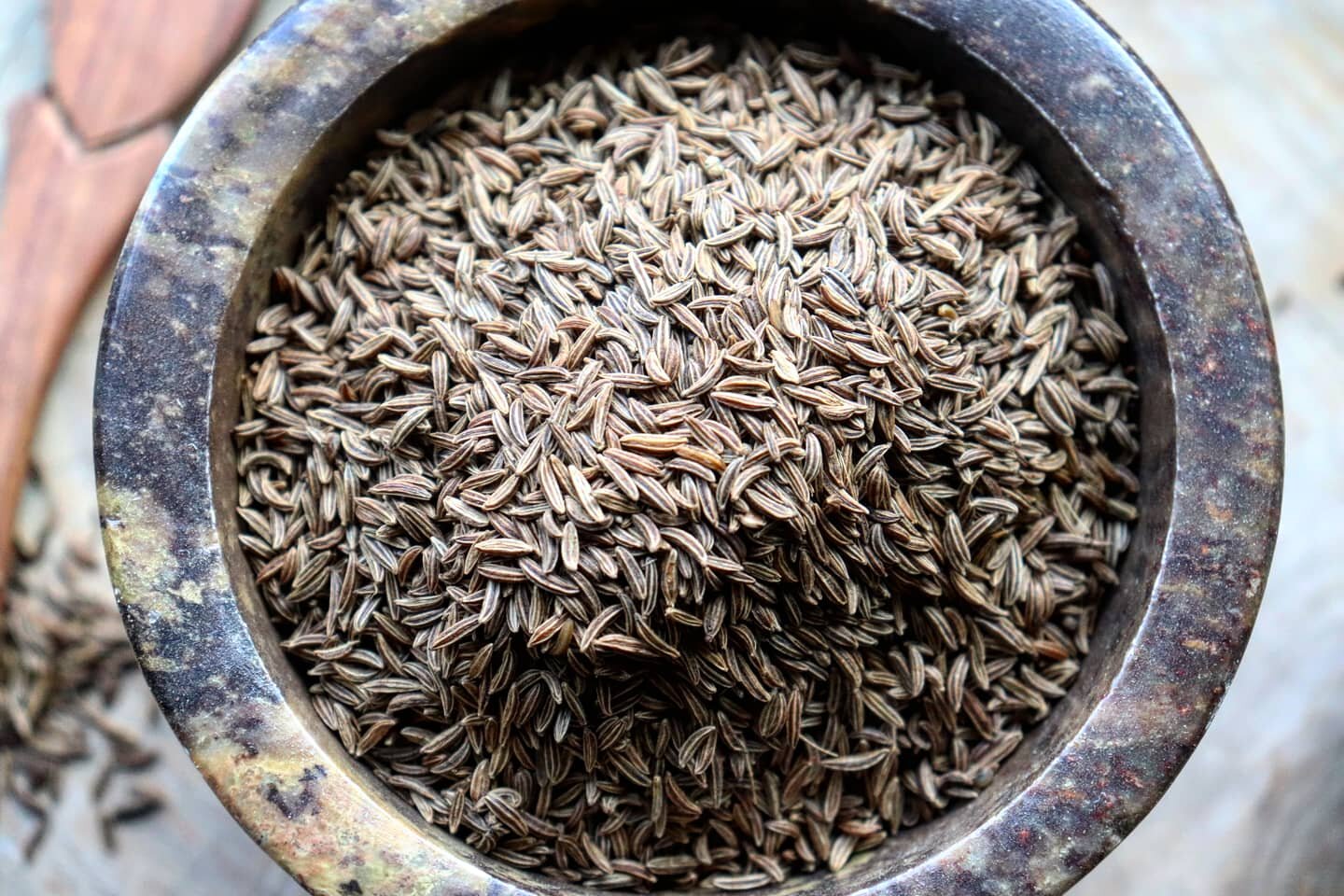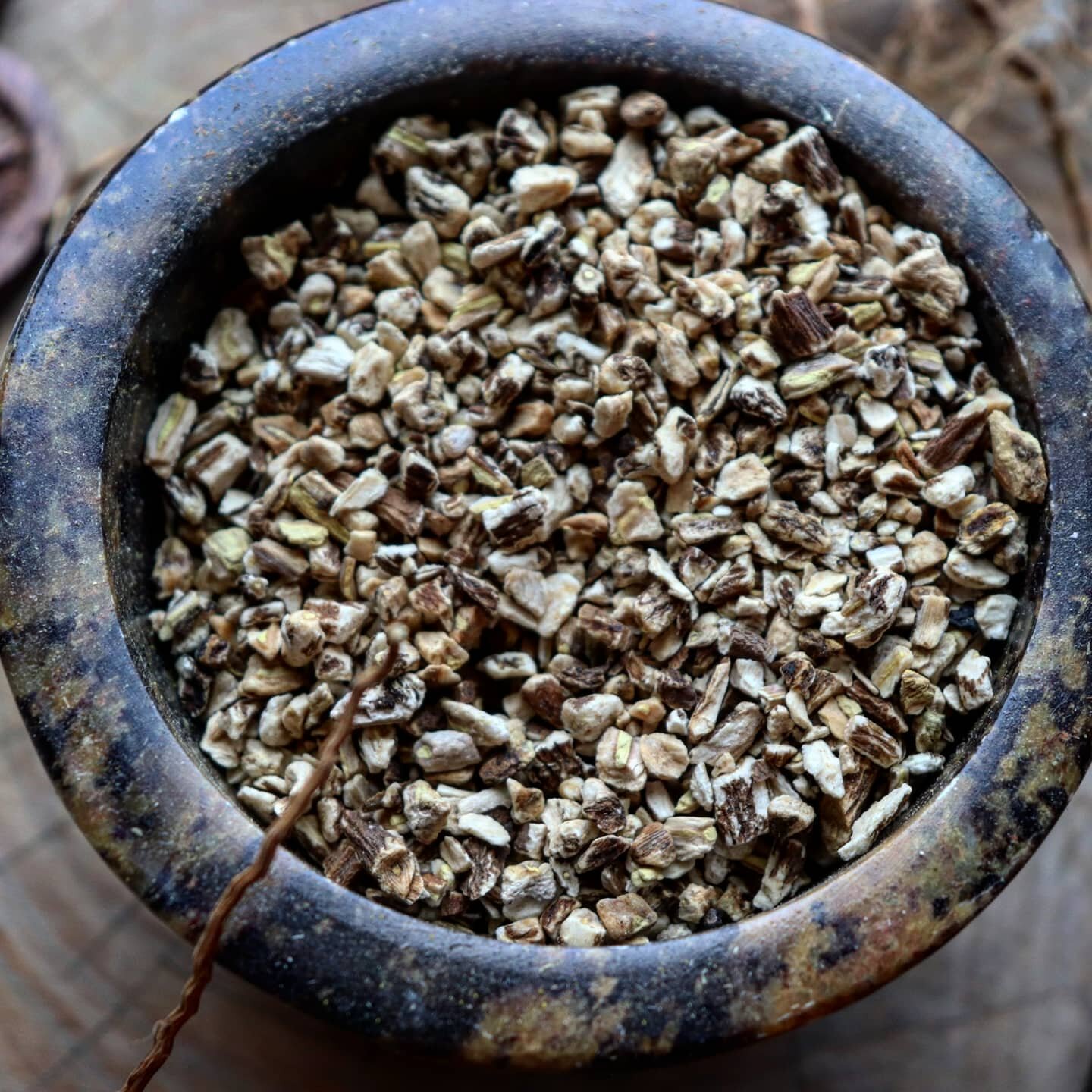 Image 1 of 2
Image 1 of 2

 Image 2 of 2
Image 2 of 2



Rue
Ruta graveolens
Cut and Sifted—available in 1 ounce or 1/2 ounce and packaged in a plastic pouch.
Rue has a long history of use in both medicine and magick, and is considered a protective herb in both disciplines. The hardy evergreen shrub is mentioned by writers from Pliny to Shakespeare and beyond, as an herb of remembrance, of warding and of healing. Early physicians considered rue an excellent protection against plagues and pestilence, and used it to ward off poisons and fleas. A Modern Herbal refers to the plant's 'disagreeable odour and flavour', but in truth, the bitterness of the leaves is only evident in large doses.
History + Folklore
Rue was once believed to improve the eyesight and creativity, and no less personages than Michelangelo and Leonardo Da Vinci regularly ate the small, trefoil leaves to increase their own. The legend of rue lives on in playing cards, where the symbol for the suit of clubs is said to be modeled on a leaf of rue.
There are concerns that rue is poisonous and can cause violent gastric reactions when taken in large doses. In addition, some people are highly sensitive to the plant's oils and can develop a severe rash when they are exposed to it and then the sun.
Historically, rue has been used to treat various poisoning- probably through induction of vomiting, and to trigger menstruation- thus it should never be used by pregnant women who hope to stay pregnant as it has a history of use as both an abortifacient and for inducing or speeding up labor. Long-term use of rue can lead to photosensitivity and some people may experience contact dermatitis from handling it.
Magickal
Healing, Mental Powers, Exorcism, Love
Masculine, Mars, Fire
Deities: Diana, Aradia
Rue is added to healing incenses and poppets.
Rue added to baths breaks all hexes and curses that may have been cast against you, and it is also added to exorcism incenses and mixtures. It is protective when hung up at the door or placed in sachets, and the leaves are used for reversal spells. It can still be hung in the home, sprinkled around you during magical workings, or worn for protection.
It is also purported to be one of the ingredients in Thieves Vinegar, used to ward off the Black Plague and was hung over doorways and windows to keep out evil spirits, and rubbed on the floors to keep out pests.
In Ancient Rome, it was believed rue could protect the eater from the Evil Eye and guarded against poisons, illness, and fleas. Because cats find the smell of rue repulsive, it was believed rue could ward off witches and their familiars as well, although some reports say rue was used by witches to help them identify each other.
It was believed to be the "protect-all" of herbs. Later it was mixed into incense to be used during exorcisms and used by the Catholic Church to sprinkle holy water on its followers to ward off evil, thus becoming known as the "herb of grace."
Warnings: Not for use in pregnancy except under the supervision of a qualified healthcare practitioner. Rue contains furanocoumarin compounds; avoid prolonged exposure to sunlight after ingestion.
Ruta graveolens
Cut and Sifted—available in 1 ounce or 1/2 ounce and packaged in a plastic pouch.
Rue has a long history of use in both medicine and magick, and is considered a protective herb in both disciplines. The hardy evergreen shrub is mentioned by writers from Pliny to Shakespeare and beyond, as an herb of remembrance, of warding and of healing. Early physicians considered rue an excellent protection against plagues and pestilence, and used it to ward off poisons and fleas. A Modern Herbal refers to the plant's 'disagreeable odour and flavour', but in truth, the bitterness of the leaves is only evident in large doses.
History + Folklore
Rue was once believed to improve the eyesight and creativity, and no less personages than Michelangelo and Leonardo Da Vinci regularly ate the small, trefoil leaves to increase their own. The legend of rue lives on in playing cards, where the symbol for the suit of clubs is said to be modeled on a leaf of rue.
There are concerns that rue is poisonous and can cause violent gastric reactions when taken in large doses. In addition, some people are highly sensitive to the plant's oils and can develop a severe rash when they are exposed to it and then the sun.
Historically, rue has been used to treat various poisoning- probably through induction of vomiting, and to trigger menstruation- thus it should never be used by pregnant women who hope to stay pregnant as it has a history of use as both an abortifacient and for inducing or speeding up labor. Long-term use of rue can lead to photosensitivity and some people may experience contact dermatitis from handling it.
Magickal
Healing, Mental Powers, Exorcism, Love
Masculine, Mars, Fire
Deities: Diana, Aradia
Rue is added to healing incenses and poppets.
Rue added to baths breaks all hexes and curses that may have been cast against you, and it is also added to exorcism incenses and mixtures. It is protective when hung up at the door or placed in sachets, and the leaves are used for reversal spells. It can still be hung in the home, sprinkled around you during magical workings, or worn for protection.
It is also purported to be one of the ingredients in Thieves Vinegar, used to ward off the Black Plague and was hung over doorways and windows to keep out evil spirits, and rubbed on the floors to keep out pests.
In Ancient Rome, it was believed rue could protect the eater from the Evil Eye and guarded against poisons, illness, and fleas. Because cats find the smell of rue repulsive, it was believed rue could ward off witches and their familiars as well, although some reports say rue was used by witches to help them identify each other.
It was believed to be the "protect-all" of herbs. Later it was mixed into incense to be used during exorcisms and used by the Catholic Church to sprinkle holy water on its followers to ward off evil, thus becoming known as the "herb of grace."
Warnings: Not for use in pregnancy except under the supervision of a qualified healthcare practitioner. Rue contains furanocoumarin compounds; avoid prolonged exposure to sunlight after ingestion.
Ruta graveolens
Cut and Sifted—available in 1 ounce or 1/2 ounce and packaged in a plastic pouch.
Rue has a long history of use in both medicine and magick, and is considered a protective herb in both disciplines. The hardy evergreen shrub is mentioned by writers from Pliny to Shakespeare and beyond, as an herb of remembrance, of warding and of healing. Early physicians considered rue an excellent protection against plagues and pestilence, and used it to ward off poisons and fleas. A Modern Herbal refers to the plant's 'disagreeable odour and flavour', but in truth, the bitterness of the leaves is only evident in large doses.
History + Folklore
Rue was once believed to improve the eyesight and creativity, and no less personages than Michelangelo and Leonardo Da Vinci regularly ate the small, trefoil leaves to increase their own. The legend of rue lives on in playing cards, where the symbol for the suit of clubs is said to be modeled on a leaf of rue.
There are concerns that rue is poisonous and can cause violent gastric reactions when taken in large doses. In addition, some people are highly sensitive to the plant's oils and can develop a severe rash when they are exposed to it and then the sun.
Historically, rue has been used to treat various poisoning- probably through induction of vomiting, and to trigger menstruation- thus it should never be used by pregnant women who hope to stay pregnant as it has a history of use as both an abortifacient and for inducing or speeding up labor. Long-term use of rue can lead to photosensitivity and some people may experience contact dermatitis from handling it.
Magickal
Healing, Mental Powers, Exorcism, Love
Masculine, Mars, Fire
Deities: Diana, Aradia
Rue is added to healing incenses and poppets.
Rue added to baths breaks all hexes and curses that may have been cast against you, and it is also added to exorcism incenses and mixtures. It is protective when hung up at the door or placed in sachets, and the leaves are used for reversal spells. It can still be hung in the home, sprinkled around you during magical workings, or worn for protection.
It is also purported to be one of the ingredients in Thieves Vinegar, used to ward off the Black Plague and was hung over doorways and windows to keep out evil spirits, and rubbed on the floors to keep out pests.
In Ancient Rome, it was believed rue could protect the eater from the Evil Eye and guarded against poisons, illness, and fleas. Because cats find the smell of rue repulsive, it was believed rue could ward off witches and their familiars as well, although some reports say rue was used by witches to help them identify each other.
It was believed to be the "protect-all" of herbs. Later it was mixed into incense to be used during exorcisms and used by the Catholic Church to sprinkle holy water on its followers to ward off evil, thus becoming known as the "herb of grace."
Warnings: Not for use in pregnancy except under the supervision of a qualified healthcare practitioner. Rue contains furanocoumarin compounds; avoid prolonged exposure to sunlight after ingestion.
For the list of herbal correspondents, click on the herb. 🌿
Our products are not intended to diagnose, treat, cure, or prevent any disease. These items are purely informational and curios. Humans are complex; therefore, results may vary depending on consumption and individual physiology. ShadowCraft and affiliates are not responsible for consequences as a result of the misuse and misrepresentation of our products.
Please be advised that you are on a site that promotes the use of and sells homeopathic & herbal supplement products that have not been evaluated by the FDA. All products sold are intended for spiritual and entertainment purposes and have no guaranteed outcome or results. The buyer assumes all responsibility for items once purchased.
As with all handmade items, the listing image may vary compared to the product received. Please refer to our shop disclaimer for additional warnings and information.


